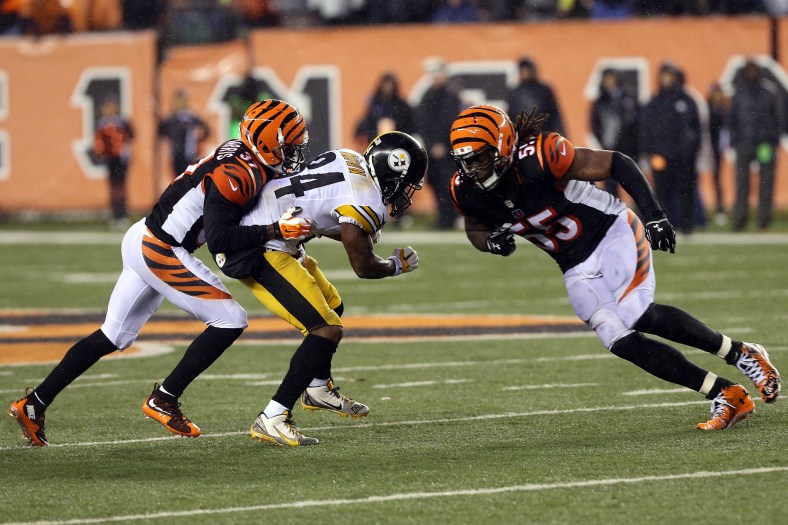
The NFL has been working overtime to make us all believe that its newfound supposed fervor for protecting players from getting concussions and playing through them will be a boon for the future of its players, and the game itself. The league recently implemented an updated concussion protocol that is supposed to keep scary things (like what happened to Tom Savage this past year) happen ever again.
Even if the new protocol was being followed by the letter by every team (it’s not — cough! cough! Cam Newton! cough!), a new study indicates it’s really just being hit that matters when it comes to the degenerative brain disease CTE (Chronic Traumatic Encephalopathy).
“It’s really the hit that counts. Although that’s the headline, this is the best scientific evidence to date, in fact some of the only scientific evidence, that we have that that’s so. … This is the first really solid evidence that we have where we have controlled experiments where we can make that case very strongly and convincingly.”
The study was led by Boston University and included scientists from top institutes from all over the world, including the United Kingdom, Israel and Canada. They analyzed the brains of four teenager athletes who passed away anywhere from one to 128 days from sustaining “closed-head impact injuries” and recreated head trauma by utilizing lab mice.
“Our findings provide strong causal evidence linking head impact to TBI and early CTE, independent of concussion,” Goldstein said. “The results may explain why approximately 20 percent of athletes with CTE never suffered a diagnosed concussion.”
One of the things that came out of this study was the need to differentiate between CTE, concussions and traumatic brain injuries, or TBI. Goldstein remarked on the difference, noting of a TBI: “it is an injury, an event,” he said. “It’s not a syndrome. It’s an event and it involves damage to tissue. If you don’t have a concussion, you can absolutely have brain injury and the converse is true.”
This is where things get really sticky as it relates to football, or other contact sports.
“You get hit the first time and a minute later you get hit again. We learned that from blasts because those happen in milliseconds. In football, it happens in minutes, tens of minutes or over a day or week. But the cumulative effect, when the brain is not fully healed, particularly in younger people, is really, really damaging,” Goldstein said, “and that’s the problem. You won’t see it by focusing on concussion. In fact it’s guaranteed that you won’t see it.
“There are many players who are hit, who are hurt and who aren’t getting help because it’s clear that they’re not at the level of concussion. Their brains are not in good shape and they go on to the next hit and the next one.”
Not surprisingly, the NFL has already issued a response to this new study, noting that the research around TBI and CTE “continues to advance the discussion, awareness and understanding around this important issue,” per Dr. Alan Sills, a neurosurgeon who is the league’s chief medical officer.
“As highlighted in this recent study, repetitive hits to the head have been consistently implicated as a cause of CTE by this research group. How and why exactly this manifests, who is at risk, and why — these are questions that we as researchers and clinicians are working to answer. As the research community continues to explore these critical questions, the NFL has made real strides to try to better protect our players and reduce contact to the head including implementing data-driven rules changes intended to eliminate potentially dangerous tactics and reduce the risk of injuries, especially to the head and neck; enforcing limits on contact practice; and mandating ongoing health and safety education for players and training for club and non-affiliated medical personnel.
“Ultimately, being active, getting outside, playing sports, particularly team sports, is important. There are also concerns about the risks involved in playing sports, including football, which is why it has been encouraging to see similar developments at the youth level such as the certification of over 130,000 youth and high school coaches through USA Football’s Heads Up program; USA Football’s National Practice Guidelines — including limits on full contact; Pop Warner’s initiatives, from no intentional head-to-head contact to requiring players who suffer a suspected head injury to receive medical clearance from a concussion specialist before returning to play; and 50 states have a Return to Play law, which can help reduce the rates of recurrent concussions. We hope that all youth sports will continue to take measures to reduce head contact through similar rules changes, education and improved protective equipment.”
Unlike in years past, CTE is being talked about in the open. Players who compete are, for the most part, well aware of the risks they are taking.
However, as we’ve delved into in the past, this isn’t just a big issue at the collegiate and professional level. It’s a huge issue for young people who compete in contact sports like hockey or football, and the risk to their developing brains is even greater (more on that here).
What it all means for the future of contact sports remains to be seen. But for what it’s worth, this scribe is in favor of exploring alternate ways to compete that do much, much more to protect athletes from the constant hitting that is involved in the game of football.